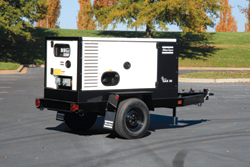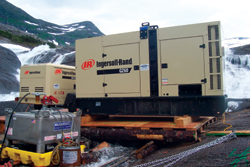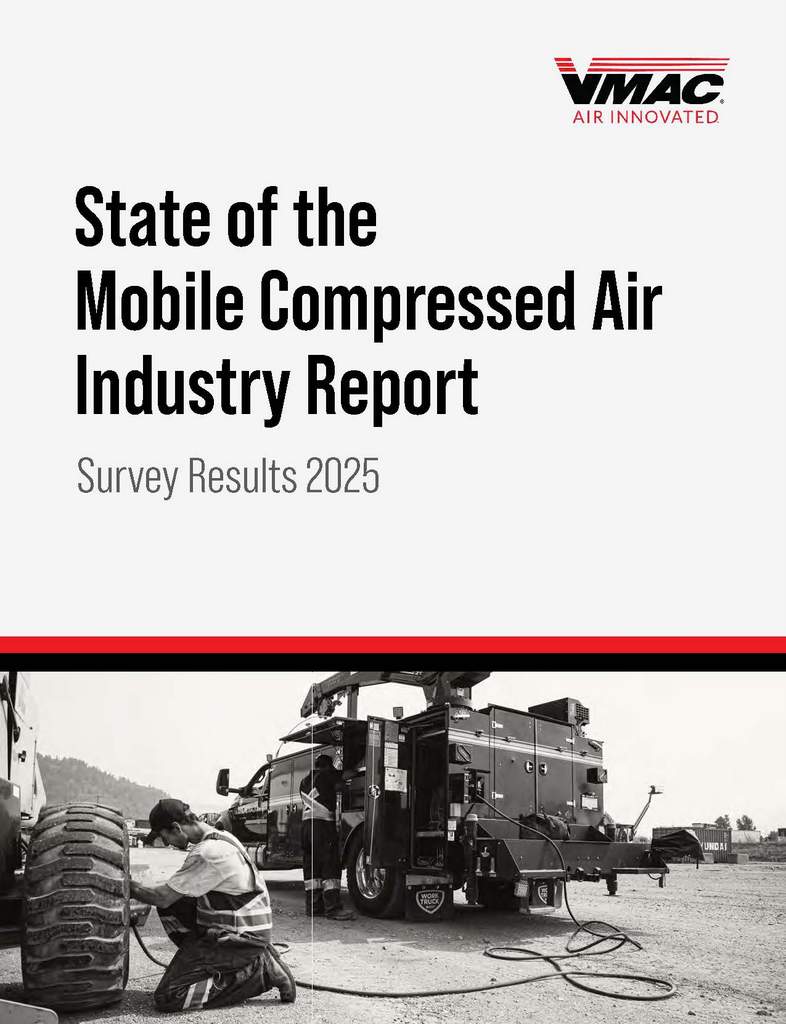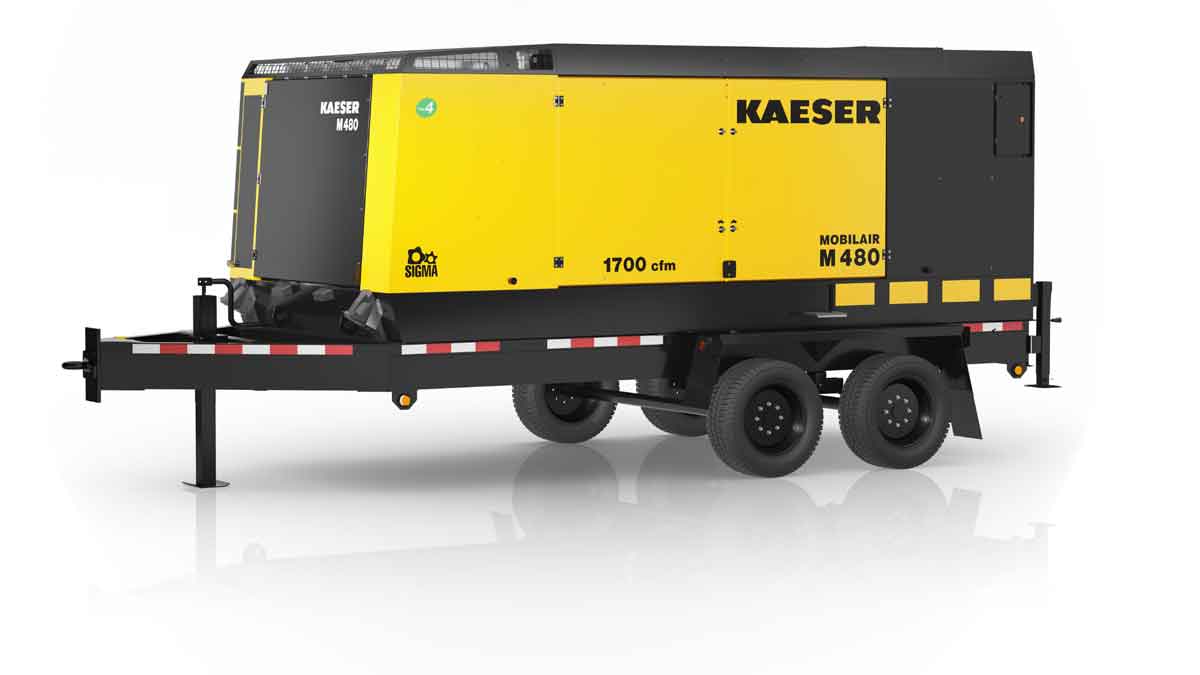Powering Through the Common Cold
Deadlines don’t care if it’s cold outside. Closing dates don’t consider how chilly your crews get in mid-winter; they don’t care if your equipment spent the night outside in the freeze and thaw. A project only knows its deadlines, regardless of cold or snow, and as the deadline approaches steadily it’s the contractor’s job to meet it.
Fitting a gen-set to a cold weather job and its timetable is similar in many ways to fitting a gen-set to most projects. In either case, the primary concern is in sizing the generator properly to the needed output. While chest-pounding and howling for more power is funny on television, over-sizing a generator may lead to issues that can shorten the life of the engine and hamper the generator’s operating capacity. Working in the cold exacerbates these issues, so sizing a generator properly is particularly important in a cold weather environment.
Wet Stacking
“The proper application of a gen-set is operating at 70 to 100 percent of its rated load,” explains Todd Howe, product marketing manager of mobile generators for Doosan Infracore Portable Power, based in Statesville, N.C. “Running at a lesser load rate can lead to problems, especially with loads of less than 30 percent.”
Since a gen-set’s engine fires at a constant 1,800 rpm rate — it isn’t sped and slowed like, say, an automotive engine — the amount of fuel pumped into the engine is more or less constant. When the gen-set operates at a light load, then it will take on more fuel than it needs — more fuel than it can burn. When that happens, oil (both in liquid and particulate form) and soot build up in and around the engine exhaust.
“Diesel engines are compression combustion engines and need to operate at temperature to perform efficiently,” explains Marc Leupi, utility product manager for Wacker Neuson. This is important since for the most part, commercial gen-sets will run on diesel fuel — gasoline powered generators are used more for consumer applications such as home power backup. “An engine not operating at temperature can experience incomplete combustion,” Leupi continues. “This is what’s known as wet stacking.”

Against the Cold, Against the Wind
A gen-set’s tendency to suffer wet stacking is increased in cold work environments. “Cold doesn’t directly affect a generator’s performance, however, cold [and altitude] does affect engine performance, which affects the generator,” says Chuck Westhofen, product marketing manager — compressors and generators with Atlas Copco. “All engines will de-rate their available horsepower based on changes in ambient temperature and altitude — some more than others.”
It is important to note what constitutes cold, temperature-wise, as it applies to a gen-set. The unit should operate normally, including startup, at 20 degrees Fahrenheit. In most cases, nothing should change down to 0 degrees, but a machine that operates in colder temperatures than those specified for extended lengths of time will start to experience the effects of the weather.
“If working temperatures are consistently sub-zero, the buyer may want to consider a cold weather package,” offers Leupi. “In extreme cold, a diesel engine can’t get to temperature on its own.”
Other factors influenced by the cold include oil viscosity and battery draw on startup. Batteries, in particular, suffer in cold temperatures. Many of the modifications to a gen-set that will be deployed in a cold weather environment address these two concerns in addition to the overall temperature of the unit.
“Once you get down in the range of 20-below-zero, you should specifically add an engine coolant heater and a battery tray warmer,” says Howe. “This will greatly aid in startup and will allow the unit to be brought to temperature more quickly.”
A common add-on to a gen-set that will see a lot of cold weather action is a shutter system that can regulate the passage of cold air through the machine and control the outflow of exhaust. Typically, these types of shutter or louvered systems are temperature-regulated, opening and closing depending on engine temperature. For this reason, these louver systems are well-suited to a machine regardless of jobsite temperature. “In fact, it can even be a benefit in situations that wouldn’t normally require such an add-on,” says Leupi. “Since they regulate to the engine’s optimum temperature, they’ll close at startup and bring the engine to temperature faster.”
Other examples of cold weather protection include coolant and oil level shutdown sensors. Oil can gel at lower temperatures and these sensors will monitor the amount of oil circulating properly through the engine. In extreme conditions, synthetic oils may be used. Similarly, the coolant sensor ensures proper levels of coolant. Electronic components can be cold weather rated — for example, LCD displays are particularly disagreeable in extreme temperatures, so screen heaters or other display options may be needed. Fuel heaters keep diesel from gelling.
Match Game
Having an idea of what’s available for cold weather gen-set applications is an important step in acquiring the right machine for the jobsite. In fact, it’s important to have a full understanding of how the machine will be deployed before you start shopping. “The most important questions concern the application of the generator,” advises Westhofen. “How will it be used? Multiple applications or just one? The buyer should have an idea what options they might need, such as a battery charger, spare tire, cam locks and so on.”
“Our dealers are consultants,” says Howe. “They size the machine to the customer’s needs in such a way that it will be 70 to 80 percent loaded. That way there’s a little bit of room above and below that load rate if the customer needs to add equipment later.”
An educated consumer will not only know his or her power requirements and which options may work best, but will also know what he or she doesn’t need. “Don’t let the dealer talk you into options you can’t use,” says Westhofen. “A battery charger and block heater won’t do much good if there’s no place to plug them in.”
The right dealer will be able to match the machine to the customer’s needs, including cold weather options. Again, this is based on the customer having a solid understanding of how and where the gen-set will be deployed.
Gen-sets for commercial use tend to start in the $15,000 range for a 20-kw model. At the upper end, a 450-kw model will run in the neighborhood of $100,000. Fitting the machine for cold weather adds anywhere from $800 to $1,500 and on up, but a gen-set that starts dependably is worth it.
Keep on Rolling
Once the gen-set is on site, it’s a matter of starting ‘er up and keeping ‘er going. As mentioned above, the bulk of the cold weather add-ons to a gen-set concern startup and bringing the engine to temperature.
“Make sure it’s warmed up before you load it up,” advises Leupi. Hammering a cold gen-set with a full load will result in either wet stacking or overload, ultimately resulting in unnecessary engine wear. Adding a load to a gen-set will bring it to temperature more quickly. As usual, common sense will prevail.

“The generator should be visually checked hourly for leaks and ice buildup that may develop,” says John Placke, technical service representative for Atlas Copco Compressors. “Monitor all engine gauges for proper temperatures and pressures and make sure the generator stays loaded.”
Maintenance schedules revolve around the oil and filters. A typical servicing schedule will see oil changes at the 500 hour mark with filter changes at 250-hour intervals. A dirtier jobsite may accelerate this schedule a bit, so keep that in mind in particularly dusty conditions. Fuel filters should be changed every 250 hours as well. In cold conditions, the fuel lines should be drained of water daily to prevent freezing.
Start Your Engines
With the right setup, a gen-set can power through the bitterest of winters. Understanding how the cold affects the fuel, the oil and the batteries is key to fitting your rig to your jobsite. The project may not care if it’s cold out, and if your gen-set is outfitted correctly, you won’t either.
Greg Thompson is contributing editor to Compact Equipment, based in Peninsula, Ohio.





Comments are closed here.